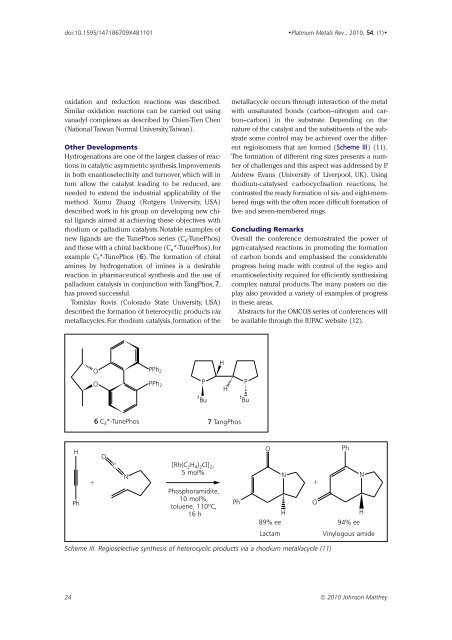Download Issue PDF - Platinum Metals Review
Download Issue PDF - Platinum Metals Review
Download Issue PDF - Platinum Metals Review
Create successful ePaper yourself
Turn your PDF publications into a flip-book with our unique Google optimized e-Paper software.
doi:10.1595/147106709X481101<br />
•<strong>Platinum</strong> <strong>Metals</strong> Rev., 2010, 54, (1)•<br />
oxidation and reduction reactions was described.<br />
Similar oxidation reactions can be carried out using<br />
vanadyl complexes as described by Chien-Tien Chen<br />
(National Taiwan Normal University,Taiwan).<br />
Other Developments<br />
Hydrogenations are one of the largest classes of reactions<br />
in catalytic asymmetric synthesis.Improvements<br />
in both enantioselectivity and turnover, which will in<br />
turn allow the catalyst loading to be reduced, are<br />
needed to extend the industrial applicability of the<br />
method. Xumu Zhang (Rutgers University, USA)<br />
described work in his group on developing new chiral<br />
ligands aimed at achieving these objectives with<br />
rhodium or palladium catalysts. Notable examples of<br />
new ligands are the TunePhos series (C n -TunePhos)<br />
and those with a chiral backbone (C n *-TunePhos),for<br />
example C 3 *-TunePhos (6). The formation of chiral<br />
amines by hydrogenation of imines is a desirable<br />
reaction in pharmaceutical synthesis and the use of<br />
palladium catalysis in conjunction with TangPhos, 7,<br />
has proved successful.<br />
Tomislav Rovis (Colorado State University, USA)<br />
described the formation of heterocyclic products via<br />
metallacycles. For rhodium catalysis, formation of the<br />
metallacycle occurs through interaction of the metal<br />
with unsaturated bonds (carbon–nitrogen and carbon–carbon)<br />
in the substrate. Depending on the<br />
nature of the catalyst and the substituents of the substrate<br />
some control may be achieved over the different<br />
regioisomers that are formed (Scheme III) (11).<br />
The formation of different ring sizes presents a number<br />
of challenges and this aspect was addressed by P.<br />
Andrew Evans (University of Liverpool, UK). Using<br />
rhodium-catalysed carbocyclisation reactions, he<br />
contrasted the ready formation of six- and eight-membered<br />
rings with the often more difficult formation of<br />
five- and seven-membered rings.<br />
Concluding Remarks<br />
Overall the conference demonstrated the power of<br />
pgm-catalysed reactions in promoting the formation<br />
of carbon bonds and emphasised the considerable<br />
progress being made with control of the regio- and<br />
enantioselectivity required for efficiently synthesising<br />
complex natural products. The many posters on display<br />
also provided a variety of examples of progress<br />
in these areas.<br />
Abstracts for the OMCOS series of conferences will<br />
be available through the IUPAC website (12).<br />
O<br />
PPh 2<br />
H<br />
O<br />
PPh 2<br />
P<br />
H<br />
P<br />
t Bu<br />
t Bu<br />
6 C 3 *-TunePhos<br />
7 TangPhos<br />
H<br />
Ph<br />
+<br />
O<br />
C<br />
N<br />
[Rh(C 2 H 4 ) 2 Cl] 2 ,<br />
5 mol%<br />
Phosphoramidite,<br />
10 mol%,<br />
toluene, 110ºC,<br />
16 h<br />
Ph<br />
O<br />
N<br />
H<br />
89% ee<br />
Lactam<br />
+<br />
O<br />
Ph<br />
N<br />
H<br />
94% ee<br />
Vinylogous amide<br />
Scheme III. Regioselective synthesis of heterocyclic products via a rhodium metallacycle (11)<br />
24 © 2010 Johnson Matthey
















